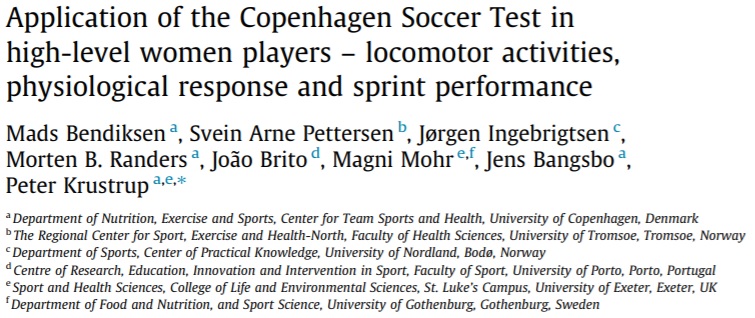Brief summary of research results
We have developed an international very visible female football research centre with inter-disciplinary results exemplified in the following.
The primary clubs were enrolled into the project and equipped with Statsport tracking systems middle of March 2020.
We used the COVID behavioural restrictions with no access to the team’s- and commercial gyms to conduct a novel investigation of whether this change in routines had a negative influence on maximal strength. Results showed that although gyms were closed, female high-level players managed to preserve strength, jumping, and sprinting abilities of high-level female football players during a ∼ 3-month period of a pandemic-induced lockdown (8) (reference number in accordance with FFRC Publication List).
Moreover, we have described the physical demands by position down to worst case scenario (WCS), 1- minute, (we have now under production a paper that shows that a 30 sec WCS will cover most of the intense activity of a 1-minute WCS). Wide positions have significant higher load including more intense 1 minute peak periods than other positions (6).
Although having reference values for two full seasons in four elite teams (3 teams were among the four best, including the champion, each season) to establish Norwegian reference values (6) we have also shown a large variability in high intensity actions between matches e.g., more than 30 % variability in sprint distance is within normal match-to- match variability due to the “inner life” of football matches. Additionally, the poor consistency of specific peak high-speed metrics in women´s elite football may raise questions regarding its practical applicability. Although the analysis of peak locomotor demands in matches has become a common trend among practitioners, its applicability as benchmarks for training sessions may be controversial (7).
Power, agility and strength show little fluctuation during the menstrual cycle, so it is not sustainable (no specific windows of opportunity) to periodize physical training in team sport in relation to menstrual cycle. However, in relation to women´s health it is crucial to take menstrual cycle into consideration (article in production) to optimize personal and team performance.
The failure of elite female players to meet the recommended levels of carbohydrate intake in conjunction with inadequate nutritional periodization, will likely hamper performance through inadequate muscle glycogen resynthesis. “Carbofobia” resulted in a considerable prevalence of low energy availability on match and training days (14).
A systematic review showed that scores on some psychological factors like, mental toughness and executive functions, seemed to increase with the competition level of the players (10). Despite this, the only psychological predictors of match performance identified was a coach created mastery climate and the personality trait extraversion (11). In addition, wellness factors such as sleep, stress, mood, and fatigue did not predict match performance when measured on match day minus one (MD-1) or MD (9).
Semi structured interviews in a qualitative study on former female elite footballers regarding the reasons for quitting elite football at an early age showed that heavy workload with the combination of studies, work, and elite-level football, led to exhaustion and burnout (12). In another study, semi-structures interviews were conducted with 11 leaders in Norwegian football organizations about the impact culture could have on the development of elite female football. The study reveals that attitudes, values, prejudices, and organizational structures all impact the ability to promote women's elite football and unlock its potential.
Link to this page







 "...these findings suggest that the Copenhagen Soccer Test for Women is a valid test of the physical demands in female soccer."
"...these findings suggest that the Copenhagen Soccer Test for Women is a valid test of the physical demands in female soccer."



